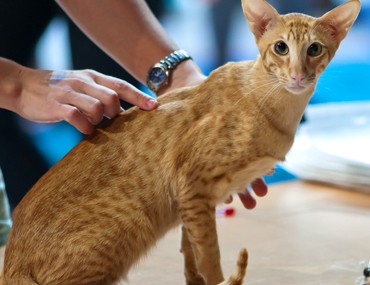History
Which came first, the Oriental or the Siamese?
The Siamese was imported to Britain from Thailand in the late 1800s. Some of these cats were “pointed,” meaning that the coat had a light background with dark points on the ears, legs, tail, and snout. But other cats were solid -colored, and after years of crossing with Russian Blues, British Shorthairs, and other breeds, the end result was the Oriental Shorthair.
Like the Siamese, the Oriental has a wedge-shaped head with big ears and almond eyes.
Registered with the CFA in the 1970s, today the Oriental is the tenth most popular cat breed in the United States. 
Cat Facts
The Oriental is a pretty neat breed, and here’s why:
- The Oriental comes in over 300 colors and patterns. Ornamental. ?
- The Oriental can be shorthaired or longhaired, depending on which gene is expressed.
- Weight: 9-14 pounds
- Lifespan: 12-15+
What are they like?
The Oriental LOVES his people.
Orientals become very attached to the people in their lives. The Oriental loves to play fetch, fool around with puzzle games, watch television, and follow you around the house. He can live with dogs and cats alike, and he’s a great cat for kids. Endlessly entertaining when you’re around, he’ll entertain himself while you’re away by exploring new heights and hiding places in the house.
The Oriental isn’t quite as loud as the Siamese – nicknamed “Meezer” because of his low-pitched voice – but he’s also never at a loss of words for anything. He’ll let you know when he’s hungry or wants to play.
The Oriental is relatively healthy breed of cat, but he does have some health issues similar to those of his cousin, the Siamese:
- Bladder stones
- Heart problems, such as dilated cardiomyopathy
- Mast cell cancer
- Liver amyloidosis, which can lead to liver failure
- Periodontal disease
Right for you?
The Oriental is a great choice for someone looking for a playful, athletic cat. But, as with all pets, there are always a few things to consider when welcoming an Oriental into your home:
- Like the Siamese, the Oriental is curious. Very curious. You’ll have to cat-proof your home to some degree, or your cat will end up tangled in wires and blinds, stuck on shelves, or into an entire bag of treats.
- Both the shorthaired and the longhaired Oriental are relatively easy to groom. A weekly brushing will keep a shorthair happy; 3-4 times a week is adequate for the longhair.
- The Oriental’s love for attention and need for stimulation can make him a bit demanding at times. They don’t like to be alone for long, so if you work long hours or your family isn’t around much, it’s best to get a companion for an Oriental.
- The Oriental is prone to periodontal disease, so he requires regular dental care. It can take some time to coax a cat into being comfortable having his teeth brushed, so you’ll have to be patient.
If you have any questions or concerns, you should always visit or call your veterinarian – they are your best resource to ensure the health and well-being of your pets.
